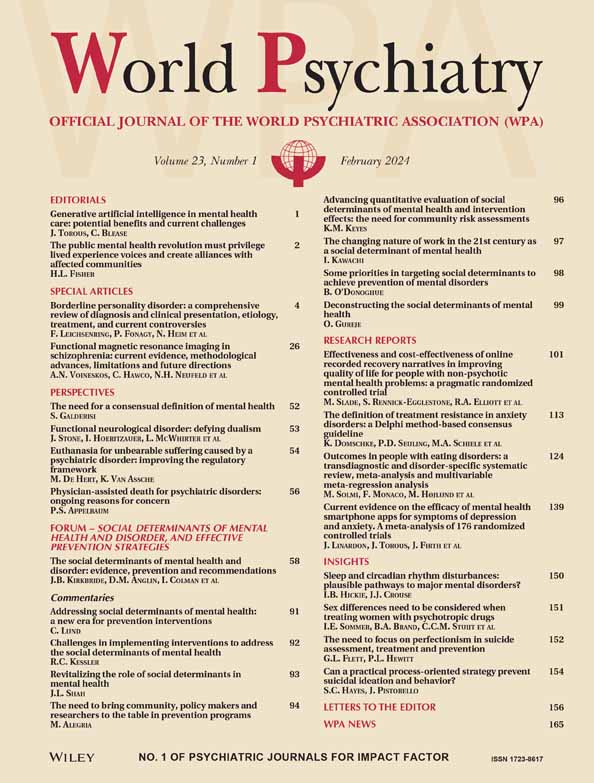Nonmedical use of prescription drugs in adolescents and young adults: not just a Western phenomenon
IF 65.8
1区 医学
Q1 PSYCHIATRY
引用次数: 44
Abstract
onists have been tested in ASD associated with fragile X syndrome, and showed promise in a subgroup of patients. GABAergic agents, such as the GABA-B receptor agonist arbaclofen (STX209), have shown some effect on irritability and social withdrawal in ASD children. The peptide hormone oxytocin is important in social cognition and behavior. In ASD adults, acute intravenous administration of oxytocin reduced repetitive behaviors and improved accuracy of recognizing emotions in speech over time. Intranasal administration improved social cognition in children, adolescents and adults with ASD. A vasopressin 1a receptor antagonist had some effect on speech recognition of emotions such as fear and lust in high-functioning ASD adults. Insulin-like growth factor 1 (IGF-1) is important in central nervous system maturation, development and connectivity, that are perturbed in ASD. Studies in Shank-3 deficient mice that model Phelan-McDermid syndrome (PMS), which may be associated with some cases of ASD, indicated that IGF-1 may reverse structural changes in ionotropic glutamate receptors, functional synaptic plasticity changes, and excitation/inhibition imbalance. A clinical trial with recombinant human IGF-1 in PMS children showed improvement in social impairment and restricted behaviors. Agents modulating the immune system have been tested in ASD. The immune response induced by the whipworm Trichuris suis ova has shown benefit on the repetitive behavior domain in adult ASD. Immunosuppressive and protein synthesis inhibiting drugs such as the mTOR inhibitor rapamycin have been shown to improve social deficits in some forms of ASD. The alpha-7 nicotinic acetylcholine receptor (nACR) gene is associated with autism and ADHD. nACR drugs tested in clinical trials include mecamylamine, transdermally administered nicotine, and donepezil. Some alpha-7 nACR antagonists such as galantamine have shown promise in animal models and clinical trials. Drugs modulating the cannabinoid system, such as cannabidiol, have been found effective in childhood epilepsy, and may be worth studying in ASD due to their anti-anxiety, antiepileptic, immunomodulating and cognitive-enhancing effects and good safety. Interestingly, social reward and oxytocin induce release of endocannabinoids in nucleus accumbens. In ASD animal models, cannabidiol has some impact on social deficits, repetitive behaviors and irritability. Complementary and alternative medicine (CAM) treatments have been tested in ASD. However, they are not strictly regulated and have not been studied in large-scale clinical trials. Therefore, their safety and efficacy is not well determined. CAM treatments may complement rather than replace proven therapies for ASD. Melatonin may be used for sleep disorders, omega-3 fatty acids for reducing repetitive behaviors and improving sociability. Vitamin B12 supplements are believed to protect against the oxidative damage in ASD. Curcumin, an active ingredient of turmeric, may be beneficial in ASD, perhaps owing to its anti-oxidant and anti-inflammatory properties. Probiotics such as yogurt may have effects on the gut microbiome and on pro-inflammatory cytokines that may play a role in the pathogenesis of ASD. In summary, the enormous heterogeneity in ASD complicates development of new pharmacotherapies. Personalized treatments are desirable, and studies of syndromal orphan populations may accelerate drug development. Design of future clinical trials needs to address patient stratification on the basis of biomarkers or etiology (for example, immune-inflammatory) and target populations stratified by clinical symptoms. New pharmacotherapies such as oxytocin/vasopressin antagonists, anti-inflammatory agents, IGF-1, drugs regulating excitation/inhibition balance, protein synthesis inhibitors, and microbiome-targeting drugs may be of particular promise. Existing drugs such as anticonvulsants, SSRIs and atypical antipsychotics may be beneficial in some patients. It is important to test the effectiveness of drugs in younger children who may benefit most from early intervention. The ultimate goal of ASD pharmacotherapy will be to match the treatment to the underlying molecular mechanisms in individual patients.在青少年和年轻人中非医疗使用处方药:不仅仅是西方现象
已经对与脆性X综合征相关的ASD患者进行了测试,并在一组患者中显示出了希望。GABA能药物,如GABA-B受体激动剂阿巴洛芬(STX209),已显示出对ASD儿童的易怒和社交退缩有一定影响。缩宫素在社会认知和行为中具有重要作用。在ASD成年人中,随着时间的推移,急性静脉注射催产素可以减少重复行为,提高识别言语情绪的准确性。鼻腔给药改善了儿童、青少年和成人ASD的社会认知。血管加压素1a受体拮抗剂对高功能ASD成年人的恐惧和欲望等情绪的语音识别有一定影响。胰岛素样生长因子1(IGF-1)在ASD的中枢神经系统成熟、发育和连接中起重要作用。对Shank-3缺陷小鼠进行的Phelan-McDermid综合征(PMS)模型研究表明,IGF-1可能逆转离子型谷氨酸受体的结构变化、功能性突触可塑性变化和兴奋/抑制失衡。一项重组人IGF-1在经前综合症儿童中的临床试验显示,社交障碍和受限行为有所改善。调节免疫系统的药物已经在ASD中进行了测试。猪鞭虫卵鞭虫诱导的免疫反应在成年ASD的重复行为领域显示出益处。免疫抑制和蛋白质合成抑制药物,如mTOR抑制剂雷帕霉素,已被证明可以改善某些形式的ASD的社会缺陷。α-7烟碱型乙酰胆碱受体(nACR)基因与自闭症和多动症有关。在临床试验中测试的nACR药物包括美卡明、经皮给药的尼古丁和多奈哌齐。一些α-7 nACR拮抗剂,如加兰他敏,已在动物模型和临床试验中显示出前景。调节大麻素系统的药物,如大麻素二醇,已被发现对儿童癫痫有效,由于其抗焦虑、抗癫痫、免疫调节和增强认知的作用以及良好的安全性,可能值得在ASD中进行研究。有趣的是,社会奖励和催产素诱导伏隔核内源性大麻素的释放。在ASD动物模型中,大麻二酚对社交缺陷、重复行为和易怒有一定影响。补充和替代药物(CAM)治疗已在ASD中进行了测试。然而,它们没有受到严格的监管,也没有在大规模临床试验中进行研究。因此,它们的安全性和有效性还没有很好地确定。CAM治疗可以补充而不是取代已证实的ASD治疗。褪黑素可用于治疗睡眠障碍,ω-3脂肪酸可用于减少重复行为和改善社交能力。维生素B12补充剂被认为可以预防ASD的氧化损伤。姜黄素是姜黄的一种活性成分,可能对ASD有益,这可能是因为它具有抗氧化和抗炎特性。酸奶等益生菌可能对肠道微生物组和促炎细胞因子产生影响,这些细胞因子可能在ASD的发病机制中发挥作用。总之,ASD的巨大异质性使新药物疗法的开发变得复杂。个性化治疗是可取的,对综合征孤儿群体的研究可能会加速药物开发。未来临床试验的设计需要根据生物标志物或病因(例如免疫炎症)和根据临床症状分层的目标人群来解决患者分层问题。新的药物疗法,如催产素/加压素拮抗剂、抗炎药、IGF-1、调节兴奋/抑制平衡的药物、蛋白质合成抑制剂和微生物组靶向药物,可能特别有前景。现有的药物,如抗惊厥药、SSRIs和非典型抗精神病药,可能对一些患者有益。测试药物对年龄较小的儿童的有效性很重要,这些儿童可能从早期干预中受益最多。ASD药物治疗的最终目标是将治疗与个体患者的潜在分子机制相匹配。
本文章由计算机程序翻译,如有差异,请以英文原文为准。
求助全文
约1分钟内获得全文
求助全文
来源期刊

World Psychiatry
医学-精神病学
自引率
7.40%
发文量
124
期刊介绍:
World Psychiatry is the official journal of the World Psychiatric Association. It is published in three issues per year.
The journal is sent free of charge to psychiatrists whose names and addresses are provided by WPA member societies and sections.
World Psychiatry is also freely accessible on Wiley Online Library and PubMed Central.
The main aim of World Psychiatry is to disseminate information on significant clinical, service, and research developments in the mental health field.
The journal aims to use a language that can be understood by the majority of mental health professionals worldwide.
 求助内容:
求助内容: 应助结果提醒方式:
应助结果提醒方式:


